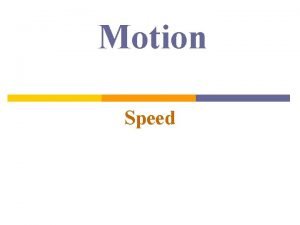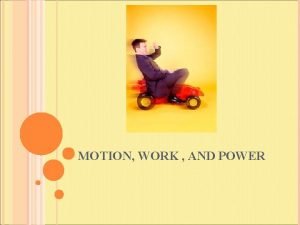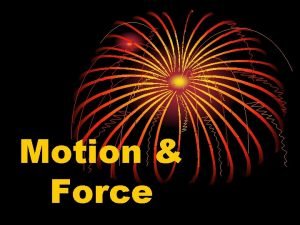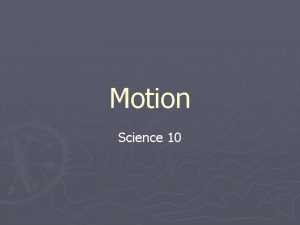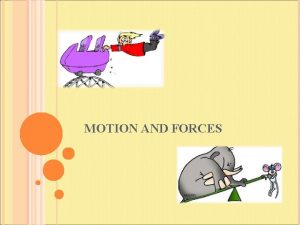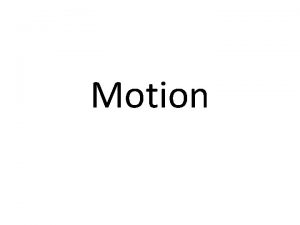MOTION MOTION Motion is the change in an












- Slides: 12

MOTION

MOTION • Motion is the change in an object’s position (or location) relative to a reference point. • A reference point is an object that appears to stay in place. • Sometimes the change in distance from a reference point to an object can be measured. • That would make the motion of the object quantifiable. • Quantifiable: able to measured in numbers.

SPEED • Speed is the distance traveled divided by the time interval during which the motion occurred. • Speed = Distance ÷ Time • Speed Units are always (Distance Units) ÷ (Time Units) • Miles/Hour (Mph), Feet/Second (fps), Kilometers/Hour (Kph) • Speed is always positive. • Speed does not include a direction. • This makes speed a SCALAR quantity • A SCALAR quantity is described only by a numerical value.

AVERAGE SPEED • Most objects do not travel at a constant speed • When you are walking somewhere you will change speeds often due to many different factors, terrain, obstacles, distractions, etc. • When driving or riding in a car or other vehicle your speed will also vary due to these different factors. • This makes calculating the average speed a very useful tool. • Average Speed = Total Distance ÷ Total Time

AVERAGE SPEED VS INSTANTANEOUS SPEED • Average speed is an average that can only be measured by using the formula Total Distance ÷ Total Time • Instantaneous speed is a measurement of the actual speed something is moving in “that moment” or “that instant” • Instantaneous speed is measured by using instruments like speedometers or radar guns.

SAMPLE AVERAGE SPEED PROBLEMS • A quarterback can throw a football 40 meters. It takes the ball 2 seconds to travel that distance. What is the Average Speed in Meters per Second? • Now the quarterback throws the ball 40 meters in 2 seconds and then the ball is intercepted and runback 10 meters in another 2 seconds. What is the average speed of the ball now?

DISTANCE VS TIME ON A GRAPH

VELOCITY • • • Velocity is the speed of an object in a specific direction. Velocity is a VECTOR quantity. This means that velocity is described using a numerical value and a direction. Velocity can be negative or positive. Velocity units are the same as speed units only with a direction added in. Mph north, Kilometers per hour south, fps up, meters per second down, etc. • An objects velocity will change if either its speed or its direction changes.

http: //www. youtube. com/watch? v=GKQdk. S 0 q. G 3 g

ACCLERATION • Acceleration is the rate at which velocity changes. • Acceleration occurs if an object’s speed, direction, or both its speed and direction change. • Acceleration can be positive or negative. • When an object’s velocity increases it is considered to be a positive acceleration. • When an object’s velocity decreases it is considered to be a negative acceleration or deceleration. • Acceleration is also a measure of how fast an object’s velocity changes. • The faster an object’s velocity changes the greater the acceleration is.

CALCULATING ACCELERATION •

MORE PRACTICE • A runner finishes the last stretch of a race in 4 seconds. During that time the runner sped up from 5 m/s to 9 m/s. What was the runners acceleration during the last stretch of the race? • After crossing the finish line the same runner takes five seconds to come to a complete stop. What is the acceleration of the runner from the time he crossed the finish line until he came to a complete stop?
 Hình ảnh bộ gõ cơ thể búng tay
Hình ảnh bộ gõ cơ thể búng tay Frameset trong html5
Frameset trong html5 Bổ thể
Bổ thể Tỉ lệ cơ thể trẻ em
Tỉ lệ cơ thể trẻ em Chó sói
Chó sói Chụp phim tư thế worms-breton
Chụp phim tư thế worms-breton Hát lên người ơi
Hát lên người ơi Các môn thể thao bắt đầu bằng tiếng chạy
Các môn thể thao bắt đầu bằng tiếng chạy Thế nào là hệ số cao nhất
Thế nào là hệ số cao nhất Các châu lục và đại dương trên thế giới
Các châu lục và đại dương trên thế giới Cong thức tính động năng
Cong thức tính động năng Trời xanh đây là của chúng ta thể thơ
Trời xanh đây là của chúng ta thể thơ Mật thư anh em như thể tay chân
Mật thư anh em như thể tay chân















